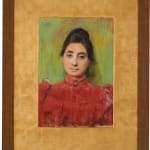Antoon van Welie (1866-1956)
Johannes Antonius (Antoon) van Welie was born in the small town of Afferden in Gelderland in the Netherlands on December 18, 1866. He studied art in Belgium and received critical acclaim in Paris. He lived between Paris, London and Rome, where he had a studio in Vatican City and received Papal commissions. A protagonist of the international Symbolist movement in his early career, Van Welie became the most celebrated Dutch portraitist, whose portraits were in demand amongst high society and celebrities throughout Europe such as Sarah Bernhardt and Isadora Duncan.[1] He exhibited at the galleries of Bernheim Jeune and George Petit in Paris, while amassing a substantial collection of old master paintings.[2] Eventually, Van Welie settled in The Hague where he remained until his death on September 24th, 1956.
Most likely, the present portrait was first exhibited in 1899 in Antwerp in a wooden annex to the Royal Museum of Fine Arts. At the request of one of his biggest early supporters, chief curator Pol de Mont (1857-1931), Van Welie contributed approximately thirty-five works, including twelve portraits.[3] After De Mont published an article in the British magazine The Studio, comparing Van Welie to the likes of Toorop, Khnopff and Minne, his international career was launched.[4] In Paris, De Mont found an ally in the influential writer Anatol France (1844-1924), who convinced Galerie de la Bodinière to take the Antwerp show that same year, explaining how this early portrait ended up in a French collection.
Although both exhibitions lack a catalogue, the model is possibly Agnes Johanna Aronstein-Lewin (1869-?), based on the likeliness of her Whistler-esque portrait in a private collection, Belgium. The Lewin family moved from Germany to ‘s Hertogenbosch, in the Netherlands, where they became acquainted with Antoon van Welie. Agnes older sister, Antonia Lewin (1858-1938), was a student of Van Welie. Portraits dated 1898 of the family, father Falk Lewin (1829-1899) and the two sisters Antonia and Agnes were included in a group show in the Netherlands that same year, where they caught the attention of Pol de Mont.[5] On 20 November 1895, the twenty-six-year-old Agnes married the German-born Joseph Aronstein (1867-1940) and the couple lived in Brussels. During World War II, Agnes lived in Barcelona, but other than that, little is known about her life.
[1] K. van Lieverloo, op.cit., pp. 8 & 34.
[2] Sale Collection Antoon van Welie, 7 April 1936, Amsterdam, Mak van Waay, with over 150 old masters.
[3] Lieverloo, op.cit., p. 105
[4] P. de Mont, "Studio-Talk", in: The Studio, October 1899, pp. 62-65
[5] Lieverloo, op.cit., p. 102
Provenance
Galerie de la Bodinière, Paris, 1899Private collection, France
Exhibitions
Antwerp, Pavillion Museum voor Schone Kunsten, Antoon van Welie, 1899
Paris, Galerie de la Bodinière, Antoon van Welie, 24 October – 24 November 1899
Literature
P. de Mont, "Antoon van Welie", De Vlaamse School, 1899, pp. 121-140 (as "een andere dame in rood gekleed op gele fon")K. van Lieverloo & P. Roelofs, Antoon van Welie. De laatste decadente schilder 1866-1956, Zwolle/Nijmegen 2007, p. 108



